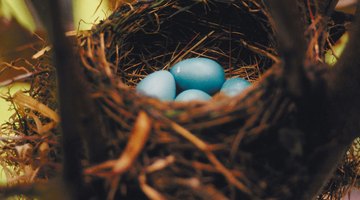How to Stop a Robin From Building a Nest
Table of Contents
All but a few birds are protected under federal laws. To keep robin nuisances down, prevent them from building nests in the first place.

The American robin (Turdus migratorius) prefers to nest in the lower branches of a large tree, but robins are also well known for building nests in gutters, eaves and on top of outdoor light fixtures. Although nests are small, they can interfere with drainage and, when built near electrical fixtures, can be unsightly and present a fire hazard. Deterrence measures include barriers and scare tactics, but if you really want to keep robins out of your eaves, provide a more attractive nesting spot elsewhere on your property.
Existing Nests Are Protected by Law
Robins are protected by the Migratory Bird Act, which makes it a federal offense to kill them, so poisons, traps and other lethal control methods are illegal. Moreover, once a nest has at least one egg in it, it is illegal to move the nest until all the hatchlings have left. You can face a large fine for violating this law, so it's best to leave an existing nest alone unless you're absolutely sure it has been abandoned. From the time a robin lays its eggs, it takes about a month for the hatchlings to leave. After the nest has been abandoned, it's safe and legal to remove it.
Use Scare Tactics
Loud random sounds, sprinklers and predator decoys can all deter robins, but each by itself has limited efficacy. Placing a fake owl in the yard, for example, may keep robins and other birds away at first, but it takes them only a few days to realize that the threat isn't real. It may help to change the owl's location periodically, but the ideal deterrent is one that doesn't require a lot of your time. Employing a combination of tactics is usually the best strategy. If you deploy a fake owl, it may help to play a random recording of an owl's screech.
If it's practical, a random jet of water from a motion-activated sprinkler will prevent robins from nesting in a particular spot, but chances are the birds will nest in a suitable spot just beyond range of the sprinkler and take advantage of the ready source of water. However, if they are in the shadow of an owl decoy making random screeching sounds, they may simply prefer to be somewhere else.
Avoid Attracting Robins
If robins find your eaves and gutters attractive, it may be because they are close to a source of food. It's possible that your yard is particularly rich in robin food, such as worms and seeds, but it's also possible they are attracted to your bird feeder. Emptying the feeder or covering it removes that particular attraction. It also means that no other birds will come around, but that may be the price you have to pay to keep the robins out of your gutters. In any case, any methods you use to deter robins will also deter other birds.
Deploy Barriers to Prevent Nest Building
An easy way to keep robins out of gutters is to install gutter guards. You can install a screen mesh or a solid barrier that allows water to drip into the far edge of the gutters while preventing access to leaves, twigs – and robins. Installing screen mesh under the soffits prevents the birds from getting into the eaves. To keep robins off flat surfaces, such as the tops of light fixtures, install pigeon spikes or some variation thereof.
Construct Hotel Robin
Like most people, you may appreciate robins, but you don't want them building nests in your house or on your light fixtures. If so, consider providing a suitable nesting spot. If you build a birdhouse or nesting shelf, make it large enough to accommodate a robin nest, which can be about 8 inches across and 6 inches high. The best place for a robin hotel is on the lower branches of a large tree, but you can also set it on a post in a secluded part of the yard.
References
Writer Bio
Chris Deziel has a bachelor's degree in physics and a master's degree in humanities. Besides having an abiding interest in popular science, Deziel has been active in the building and home design trades since 1975. As a landscape builder, he helped establish two gardening companies.
Photo Credits
- Jupiterimages/Photos.com/Getty Images
- Jupiterimages/Photos.com/Getty Images
More Articles


